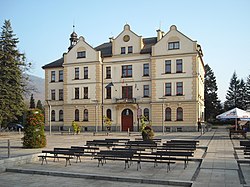Ustroń
| Ustroń | |||
|---|---|---|---|

Town Hall
|
|||
|
|||
| Coordinates: 49°43′9.82″N 18°48′43″E / 49.7193944°N 18.81194°E | |||
| Country |
|
||
| Voivodeship | Silesian | ||
| County | Cieszyn | ||
| Gmina | Ustroń (urban gmina) | ||
| First mentioned | 1305 | ||
| Town rights | 1956 | ||
| Government | |||
| • Mayor | Ireneusz Adam Szarzec | ||
| Area | |||
| • Total | 58.92 km2 (22.75 sq mi) | ||
| Population (2007) | |||
| • Total | 15,414 | ||
| • Density | 260/km2 (680/sq mi) | ||
| Time zone | CET (UTC+1) | ||
| • Summer (DST) | CEST (UTC+2) | ||
| Postal code | 43-450 | ||
| Car plates | SCI | ||
| Website | http://www.ustron.pl | ||
Ustroń [ˈustrɔɲ] (German: Ustron) is a health resort town in Cieszyn Silesia, southern Poland. It is situated in the Silesian Voivodeship (since 1999), having previously been in Bielsko-Biała Voivodeship (1975–1998). It lies in the Silesian Beskids mountain range.
It is the home of the Jan Jarocki Museum, which was founded in April 1986 as Museum of Metallurgy. It is housed in an old building of the former Klemens Steel Works, which was in use between 1772 and 1897. The museum collects technical tools, as well as historical and ethnographic artifacts.
The Równica and Czantoria mountains are nearby and hikable from the town center.
The settlement was first mentioned in a Latin document of Diocese of Wrocław called Liber fundationis episcopatus Vratislaviensis from around 1305 as item in Ustrona. It meant that the village was in the process of location (the size of land to pay a tithe from was not yet precise). The creation of the village was a part of a larger settlement campaign taking place in the late 13th century on the territory of what would later be known as Upper Silesia.
Politically, the village belonged initially to the Duchy of Teschen, formed in 1290 in the process of feudal fragmentation of Poland, and was ruled by a local branch of Piast dynasty. In 1327, the duchy became a fee of Kingdom of Bohemia, which, after 1526, became part of the Habsburg Monarchy.
...
Wikipedia



